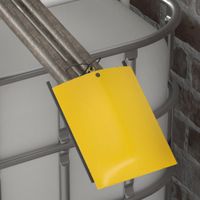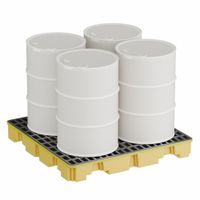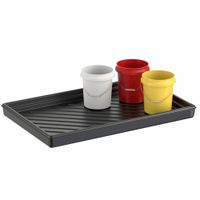Call +(254) 703 030 000 / 751 483 999 / 721 704 777
.....Read More
Frequently Asked Questions
What are the different types of sorbents and their uses?
Sorbents are materials used to absorb or adsorb liquids or gases. They are classified into three main types: absorbents, adsorbents, and bio-sorbents.
1. **Absorbents**: These materials take in liquids or gases into their structure, causing them to swell. Common absorbents include sponges, peat moss, and certain polymers. They are widely used in spill response, particularly for oil spills, where they soak up the oil from water surfaces. In industrial applications, absorbents are used to manage leaks and spills of hazardous liquids.
2. **Adsorbents**: These materials attract and hold substances on their surface without swelling. Activated carbon, silica gel, and zeolites are typical adsorbents. Activated carbon is extensively used in water purification, air filtration, and gas masks due to its high surface area and ability to trap contaminants. Silica gel is commonly used as a desiccant to control humidity and prevent spoilage or corrosion. Zeolites are used in catalysis and ion-exchange processes, such as water softening.
3. **Bio-sorbents**: Derived from natural materials, bio-sorbents include algae, fungi, and agricultural waste products. They are particularly effective in removing heavy metals and dyes from wastewater. Bio-sorbents are gaining attention due to their low cost, abundance, and environmental friendliness. They are used in environmental cleanup and wastewater treatment processes.
Each type of sorbent has specific applications based on its properties, such as capacity, selectivity, and reusability. The choice of sorbent depends on the nature of the substance to be removed, the environment in which it is used, and economic considerations.
How do I choose the right spill kit for my needs?
To choose the right spill kit, first assess the type of liquids you handle. Identify whether they are oil-based, chemical, or water-based, as spill kits are designed for specific substances. For oil spills, select an oil-only kit; for chemical spills, a chemical spill kit; and for water-based or general-purpose spills, a universal or general-purpose kit.
Next, consider the volume of potential spills. Estimate the largest possible spill and choose a kit with sufficient absorbent capacity. Kits come in various sizes, from small portable bags to large wheeled bins, so select one that matches your spill volume needs.
Evaluate the environment where the spill kit will be used. For outdoor or marine environments, ensure the kit is weather-resistant. For indoor use, consider the storage space available and choose a kit that fits comfortably.
Check the contents of the spill kit. Essential items include absorbent pads, socks, pillows, disposal bags, and personal protective equipment (PPE) like gloves and goggles. Ensure the kit includes all necessary components for your specific spill type and environment.
Consider the ease of use and accessibility. The kit should be easy to deploy quickly in an emergency. Ensure it is stored in a visible, easily accessible location and that staff are trained in its use.
Finally, review regulatory requirements. Ensure the spill kit complies with local, state, and federal regulations regarding spill response and environmental protection.
By considering these factors—type of liquid, spill volume, environment, kit contents, ease of use, and regulatory compliance—you can select the most appropriate spill kit for your needs.
What is the difference between absorbent and adsorbent materials?
Absorbent materials take in and retain substances through their entire volume. This process involves the penetration of the absorbate into the absorbent's internal structure, leading to a uniform distribution throughout the material. Common examples include sponges soaking up water or paper towels absorbing spills. The process is typically slower and involves a change in the physical state or volume of the absorbent.
Adsorbent materials, on the other hand, attract and hold substances on their surface. Adsorption is a surface phenomenon where the adsorbate molecules adhere to the surface of the adsorbent without penetrating its internal structure. This process is usually faster and does not involve a significant change in the adsorbent's volume. Activated carbon and silica gel are typical adsorbents, often used for purifying gases or liquids by trapping impurities on their surfaces.
The key differences lie in the mechanism and location of the substance uptake. Absorption involves volume and often results in a chemical or physical change, while adsorption is limited to the surface and is primarily a physical process. These differences influence their applications: absorbents are used for tasks like cleaning spills, while adsorbents are used in filtration and purification processes.
How do spill containment pallets work?
Spill containment pallets are designed to prevent and manage spills of hazardous liquids, ensuring environmental safety and compliance with regulations. They are typically used in industries where chemicals, oils, or other potentially harmful liquids are stored in drums or containers.
These pallets are constructed with a built-in sump, a basin-like structure that captures and contains any leaks or spills from the containers placed on top. The sump is the key feature, as it provides a secondary containment system that prevents the spilled liquid from reaching the ground or entering the drainage system, thus minimizing environmental contamination.
Spill containment pallets are made from durable materials such as polyethylene, which is resistant to chemicals and corrosion. This ensures that the pallets can withstand exposure to various substances without degrading. Some pallets are also made from steel for added strength and durability, especially in industrial settings.
The design of spill containment pallets includes a grated surface that allows liquids to flow into the sump while keeping the containers stable and elevated. The grates are often removable, making it easier to clean the sump and maintain the pallet.
These pallets come in various sizes and configurations to accommodate different numbers and sizes of containers, from single-drum pallets to those that can hold multiple drums. They are also available with features like forklift pockets for easy transportation and loading.
By using spill containment pallets, businesses can effectively manage the risk of spills, protect the environment, and comply with safety regulations such as the Environmental Protection Agency (EPA) and Occupational Safety and Health Administration (OSHA) standards.
What are the best practices for using spill containment berms?
1. **Site Assessment**: Evaluate the area where the berm will be used to ensure it is suitable for containment. Consider factors like ground stability, slope, and potential environmental impact.
2. **Material Selection**: Choose berms made from durable materials resistant to the chemicals or substances being contained. Common materials include PVC, polyurethane, and reinforced geomembranes.
3. **Size Appropriateness**: Select a berm size that accommodates the volume of potential spills, ensuring it can contain the maximum possible spill volume.
4. **Proper Installation**: Follow manufacturer instructions for setup. Ensure the ground is level and free of sharp objects that could puncture the berm. Secure the berm edges to prevent collapse.
5. **Regular Inspection**: Conduct frequent inspections for wear and tear, punctures, or any signs of degradation. Address any issues immediately to maintain integrity.
6. **Training**: Ensure personnel are trained in the proper use, maintenance, and emergency procedures related to spill containment berms.
7. **Secondary Containment**: Use berms as part of a broader spill containment strategy, including secondary containment systems like dikes or trenches.
8. **Environmental Considerations**: Ensure berms are used in compliance with environmental regulations and guidelines to prevent contamination of surrounding areas.
9. **Emergency Preparedness**: Have a spill response plan in place, including necessary equipment and trained personnel to handle potential spills quickly and efficiently.
10. **Maintenance and Storage**: Clean and store berms properly after use to extend their lifespan. Ensure they are dry and free from contaminants before storage.
11. **Documentation**: Keep records of inspections, maintenance, and any incidents involving the berms to ensure compliance and improve future spill response strategies.
How can I prevent oil and debris from entering storm drains?
To prevent oil and debris from entering storm drains, implement the following strategies:
1. **Regular Maintenance**: Conduct routine inspections and cleaning of storm drains to remove accumulated debris. Use catch basin inserts or filters to trap debris and oil before they enter the drainage system.
2. **Proper Waste Disposal**: Dispose of oil, chemicals, and other hazardous materials at designated facilities. Avoid pouring these substances down drains or onto the ground.
3. **Spill Prevention and Response**: Use drip pans and absorbent materials to catch leaks from vehicles and equipment. Have spill kits readily available to quickly address any accidental spills.
4. **Landscaping and Vegetation**: Plant grass, shrubs, or trees around storm drains to naturally filter runoff. Use permeable paving materials to reduce surface runoff and allow water to infiltrate the ground.
5. **Public Education**: Educate the community about the importance of keeping storm drains clean. Encourage practices like sweeping driveways instead of hosing them down and properly disposing of pet waste.
6. **Construction Site Management**: Implement erosion and sediment control measures at construction sites. Use silt fences, sediment basins, and other best management practices to prevent debris from entering storm drains.
7. **Vehicle Maintenance**: Regularly maintain vehicles to prevent oil leaks. Encourage the use of car washes that treat and recycle water instead of washing cars on driveways where runoff can carry oil into storm drains.
8. **Street Sweeping**: Implement regular street sweeping programs to remove debris and pollutants from roadways before they can enter storm drains.
9. **Community Involvement**: Organize community clean-up events to remove litter and debris from streets and public areas, reducing the risk of these materials entering storm drains.
By adopting these practices, you can significantly reduce the amount of oil and debris entering storm drains, protecting water quality and the environment.
What materials are commonly used in spill containment products?
Spill containment products are essential for managing and mitigating spills of hazardous and non-hazardous materials. Common materials used in these products include:
1. **Polypropylene**: This is a highly absorbent material often used in absorbent pads, rolls, and socks. It is effective for absorbing oil, water, and chemical spills.
2. **Polyethylene**: Known for its chemical resistance and durability, polyethylene is used in spill pallets, containment berms, and trays. It provides a robust barrier to prevent spills from spreading.
3. **Polyurethane**: This flexible material is used in drain covers and spill barriers. It can conform to surfaces to create a tight seal, preventing spills from entering drains or spreading.
4. **Rubber**: Used in mats and berms, rubber provides a non-slip surface and can contain spills effectively. It is resistant to a wide range of chemicals.
5. **Foam**: Often used in booms and socks, foam materials can float on water, making them ideal for containing oil spills on water surfaces.
6. **Activated Carbon**: Incorporated into some absorbent products, activated carbon can adsorb volatile organic compounds (VOCs) and other hazardous substances, reducing odors and potential hazards.
7. **Natural Fibers**: Materials like cotton, wool, and cellulose are used in eco-friendly absorbents. They are biodegradable and can be effective for absorbing oil and water-based spills.
8. **Metal**: Steel and aluminum are used in the construction of spill containment pallets and platforms, providing strength and durability for heavy-duty applications.
These materials are selected based on their absorbency, chemical resistance, durability, and environmental impact, ensuring effective spill management across various industries.
How do I properly dispose of used sorbents and spill containment materials?
To properly dispose of used sorbents and spill containment materials, follow these steps:
1. **Identify the Contaminant**: Determine the type of substance absorbed by the sorbents. This could be oil, chemicals, or hazardous materials. The disposal method depends on the nature of the contaminant.
2. **Consult Regulations**: Check local, state, and federal regulations regarding hazardous waste disposal. The Environmental Protection Agency (EPA) and other local environmental agencies provide guidelines for disposing of hazardous materials.
3. **Segregate Waste**: Separate contaminated sorbents based on the type of absorbed material. Do not mix different types of hazardous waste, as this can complicate disposal and increase risks.
4. **Use Proper Containers**: Place used sorbents in appropriate containers. Use leak-proof, labeled containers that comply with regulatory standards for hazardous waste. Ensure containers are sealed to prevent leaks or spills.
5. **Label Containers**: Clearly label containers with the type of waste, date of accumulation, and any hazard warnings. This is crucial for safe handling and compliance with regulations.
6. **Store Safely**: Store the containers in a designated, secure area away from incompatible materials and potential ignition sources. Ensure the storage area is compliant with safety regulations.
7. **Arrange for Disposal**: Contact a licensed hazardous waste disposal company to handle the waste. They will have the expertise and permits required to transport and dispose of hazardous materials safely.
8. **Maintain Records**: Keep detailed records of the waste disposal process, including the type and quantity of waste, disposal method, and any documentation provided by the disposal company. This is important for regulatory compliance and audits.
9. **Training and Procedures**: Ensure all personnel involved in spill response and waste disposal are trained in proper procedures and safety protocols to minimize risks and ensure compliance.
What are the regulations and compliance requirements for spill control products?
Regulations and compliance requirements for spill control products are primarily governed by environmental protection and occupational safety standards. Key regulations include:
1. **Environmental Protection Agency (EPA)**: The EPA mandates that spill control products must comply with the Clean Water Act (CWA) and the Oil Pollution Act (OPA). These laws require facilities to have Spill Prevention, Control, and Countermeasure (SPCC) plans to prevent oil spills into navigable waters and adjoining shorelines.
2. **Occupational Safety and Health Administration (OSHA)**: OSHA requires that workplaces have appropriate spill containment and cleanup measures to protect workers. This includes compliance with the Hazardous Waste Operations and Emergency Response (HAZWOPER) standards, which outline training and equipment requirements for handling hazardous spills.
3. **Department of Transportation (DOT)**: The DOT regulates the transportation of hazardous materials, including spill control products, under the Hazardous Materials Regulations (HMR). These regulations ensure safe packaging, labeling, and transportation to prevent spills during transit.
4. **State and Local Regulations**: Many states have additional requirements for spill control, often mirroring federal regulations but with stricter enforcement or additional provisions. Facilities must comply with both federal and state regulations.
5. **Product Standards**: Spill control products must meet specific standards, such as those set by the American Society for Testing and Materials (ASTM) or the National Fire Protection Association (NFPA), to ensure effectiveness and safety.
6. **Recordkeeping and Reporting**: Facilities must maintain records of spill incidents and response actions, and report significant spills to appropriate authorities as required by the Emergency Planning and Community Right-to-Know Act (EPCRA).
Compliance with these regulations ensures environmental protection, worker safety, and legal adherence, minimizing the impact of spills on health and the environment.
How do I maintain and inspect spill containment systems?
To maintain and inspect spill containment systems, follow these steps:
1. **Regular Inspections**: Conduct routine inspections to check for any signs of wear, damage, or leaks. Look for cracks, corrosion, or any structural weaknesses in the containment area.
2. **Cleaning**: Keep the containment area clean and free of debris. Regularly remove any accumulated liquids or materials to prevent overflow and ensure the system functions properly.
3. **Check Seals and Liners**: Inspect seals and liners for integrity. Ensure they are intact and not showing signs of degradation. Replace any damaged components immediately.
4. **Test Drainage Systems**: If the system includes drainage, test it to ensure it is not clogged and functions correctly. Clear any blockages promptly.
5. **Monitor for Spills**: Use sensors or manual checks to monitor for spills. Immediate detection allows for quick response, minimizing environmental impact.
6. **Review Capacity**: Ensure the containment system has adequate capacity for the materials stored. Adjust or upgrade the system if storage needs increase.
7. **Documentation**: Keep detailed records of inspections, maintenance activities, and any incidents. This documentation is crucial for compliance and future reference.
8. **Training**: Ensure all personnel involved in handling and maintaining the system are properly trained. They should know how to inspect, maintain, and respond to spills effectively.
9. **Compliance Check**: Regularly review local, state, and federal regulations to ensure the system complies with all legal requirements. Update practices as necessary.
10. **Emergency Preparedness**: Have a spill response plan in place. Ensure all staff are familiar with emergency procedures and have access to necessary equipment.
By following these steps, you can ensure your spill containment system remains effective and compliant with regulations.





